Salford Docks Area to Have Parking Ban
Page 40

If you've noticed an error in this article please click here to report it so we can fix it.
APARKING ban covering 'a number of streets in Salford's dock area was approved by the city council last week. It will apply to commercial vehicles as well as cars.
During the discussion, Aid. E. A. Hardy criticized the Manchester Ship Canal Co., claiming that they had not tried to help in easing the traffic situation. They had, be aclared, adopted "most unco-operative" attitude.
After the meeting, a representative of The Commercial Motor saw Mr. John Hollis, public relations officer of the company, who expressed surprise at Aid. Hardy's statement. He pointed out that two schemes had already been brought into operation to ease the problem.
.First, a large space had been cleared directly inside Aubrey Street gates, which gave access to the largest of the docks. A considerable number of vehicles could be held there_ The second scheme was still in the experimental stage. Through it, preference was given to " pre-advised " vehicles—those scheduled for arrival between specific hours. If full use were made of the new facility, vehicles calling for goods would have far less waiting to do, resulting in fewer lorries being parked in side streets.
Both Mr. Hollis and Mr. W. N. Farnorth, north western (eastern) area executive officer of the Road Haulage Association, agreed that many vehicles which parked in the dock area were passing through. Drivers stopped there to visit cafés, they explained. In any case, the docks were not designed to carry 60 per cent, road traffic, so some vehicles had to be kept waiting.
Nalgo-Tilling Talks Make Headway " SOME headway" in "securing that future negotiations for all companies in the Tilling group will be conducted at national level, instead of by the individual company managements," is reported by the National and Local Government Officers' Association. The discussions concern the salaries and conditions of administrative and clerical staff. Further negotiations are to take place, it is understood.
On the B.E.T. side, Nalgo are to discuss with two local Members of Parliament, who have been supporting the Association, the refusal of the Potteries Motor Traction Co., Ltd., to recognize Nalgo. Efforts are to be made also to persuade Mr. a M. Sinclair, general manager of the Birmingham and Midland Motor Omnibus Co., Ltd., to change his mind on the question of recognizing Nalgo.
Small British InterState Traffic A TABLE contained in the " 1957 Bulletin of Transport Statistics for Europe," published by the United Nations, Geneva, at 9s., indicates how little Britain participated in international „road haulage in that year, in comparison with other nations. Tonnage brought into Britain from abroad by road vehicle was 2,908 and that taken out was 7;570. Respective figures for Western Germany were 3,488,845 and 2,593,175, Holland 2,927,053 and 3,234,530, and Denmark 173,679 and 637,754. Dutch vehicles made 128,132 entries into Western Germany and Swiss 47,443, respective increases of 23 and 14 per cent, on the figures for 1956. The total of Continental vehicles entering Britain was 1,014-124 per cent, higher than in the previous year. Of 58 British lorries that went to the Continent, 41 were destined for Western Germany.
Apart from Russia with 1,506,000 miles, France has the largest road network in 'Europe at 1,156,000 miles, the British system being third biggest at 306,018 miles.
Figures for Russia do not appear in a table giving the numbers of buses and coaches in different countries, Otherwise, the British total, at 75,117, is by far the largest, second greatest being France with 33,000. The British total of 1,257,000 goods vehicles is second to the French figure of 1.338,000, and is followed by Western Germany with 636,871 and Italy with an aggregate of 480,196.
NOW A RODEN I4-TON SEMITRAILER AS PREDICTED M The Commercial Motor on November 7, Boden Trailers, Ltd., Royton, Oldham, who recently commenced production of 12-ton semi-trailers, are to manufacture also a 14-ton model.
Like the smaller semi-trailer, it will incorporate the Cary Laminaire system of leaf-spring suspension for its tubular rear axle and will be fitted with Girling vacuum braking.
Complete with a timber platform body 27 ft. long and 7 ft. 6 in. wide, it will weigh 21 tons. Fully equipped with mudguards, rear lights, reflectors, numberplate holders and 9.00-20-in. (12-ply) tyres, the semi-trailer will cost £820.
NO STANDING?
THE employers are to reply shortly to a request, made last week by the trade-union members of the National Joint Council for the municipal passenger transport industry, for the abolition of standing in municipal buses








































































































